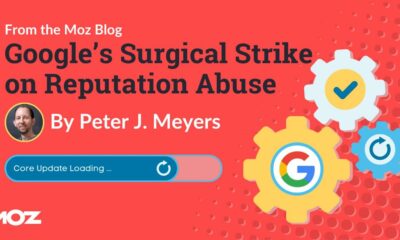SEO
Cannibalization’s Good Twin (SEO Study)
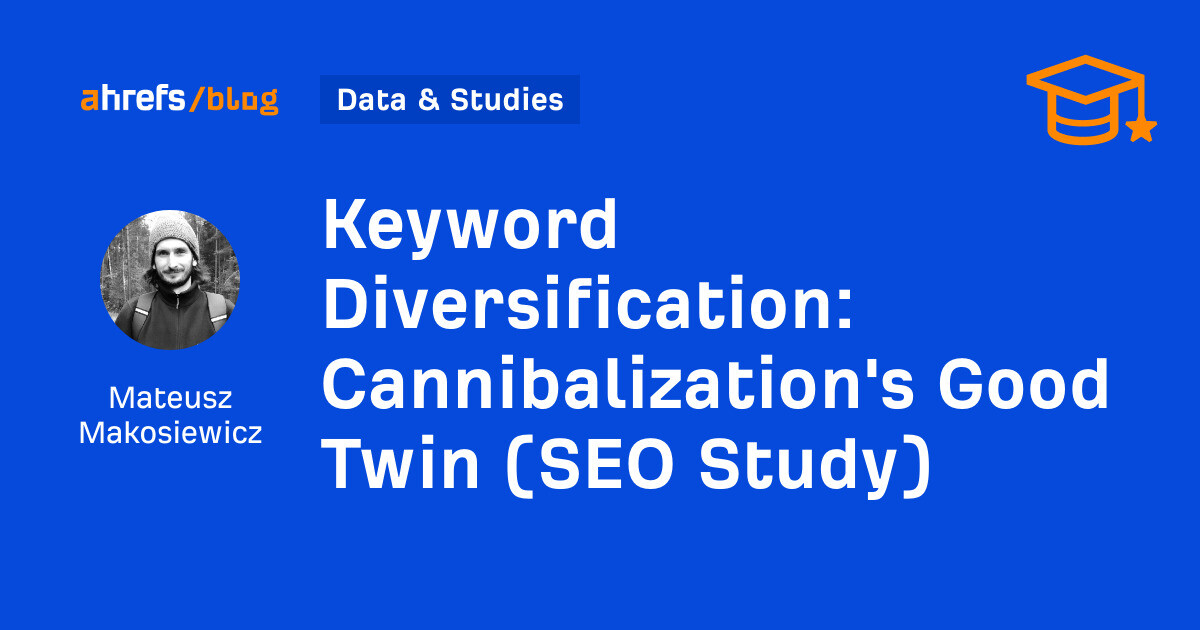
At Ahrefs.com we’ve got 9.7k cases of multiple rankings. It’s when a site ranks for a keyword with more than one page.
Now, classic SEO theory says that if you rank with more than one page for a keyword, it’s a cannibalization issue, and you should fix it.
But when I spent a day carefully reviewing a sample of 80 keywords with multiple rankings, I found only one case that needed action.
So if all other cases were not bad, maybe they were actually good? Moreover, maybe you should target keywords with more than one page to squeeze out more traffic from a keyword?
Keyword cannibalization: bad multiple rankings
Keyword cannibalization is when a search engine constantly exchanges ranking between multiple pages or when multiple pages rank simultaneously for the same keyword but are similar enough to be consolidated.


These cases need fixing because Google will display only one page at a time or you could get more traffic by rolling content under one page.
Example: “seo case studies”
For the keywords “seo case studies” and “seo case study”, we saw a group of blog posts constantly exchanging rankings in the SERPs.
Although each case study had a different URL, the phrase “case study” in each title and URL may have triggered cannibalization.
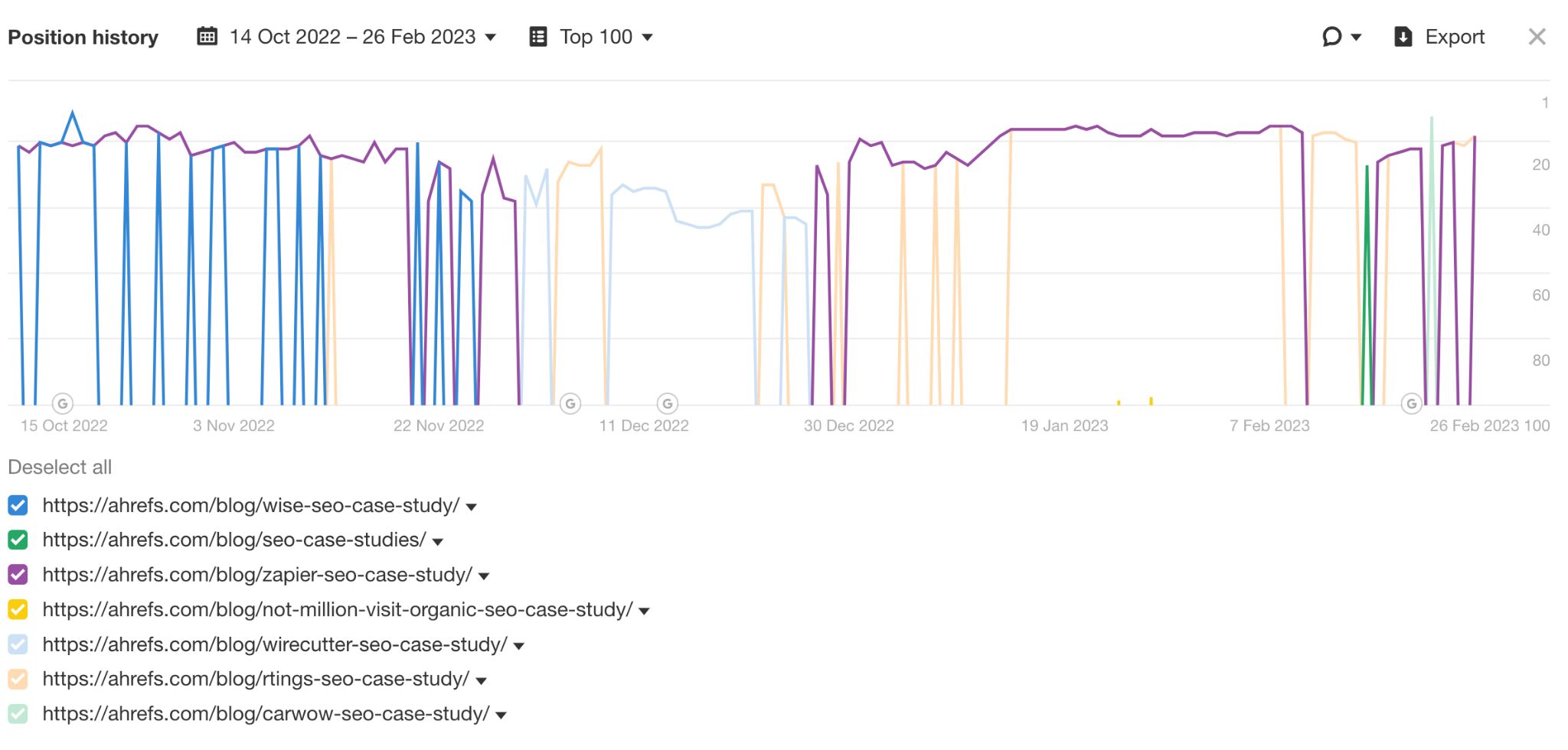

This meant that whenever we published a new case study, the old one was dropped from the SERPs and substituted with the new one.
We fixed the issue by creating a bare-bones pillar page with internal links to all of our case studies. Google ranked the pillar page as the main result with a selection of case studies as site links.
As a result of consolidating, we rank better with one page than we ever did with several. We almost instantly ranked in the top 10 and have remained in the top 3, most of the time giving way only to Google’s page on the same topic. Some of the case studies even ranked as site links to the pillar page.


Example: “broken link building”
For this keyword, we used to have two guides. As you can see below, these rankings didn’t swap, they ranked simultaneously in the top 10 for a long time.


However, we managed to improve that result with a new guide that consolidated information from the old guides — this is the long pink line you can see in the chart below.


So, this was a case of cannibalization because these pages were close enough in terms of content. In such cases, consolidating content can bring better results.
Keyword diversification: good multiple rankings
Keyword diversification is when two or more pages rank for the same keyword simultaneously, and there is likely no benefit in consolidating.
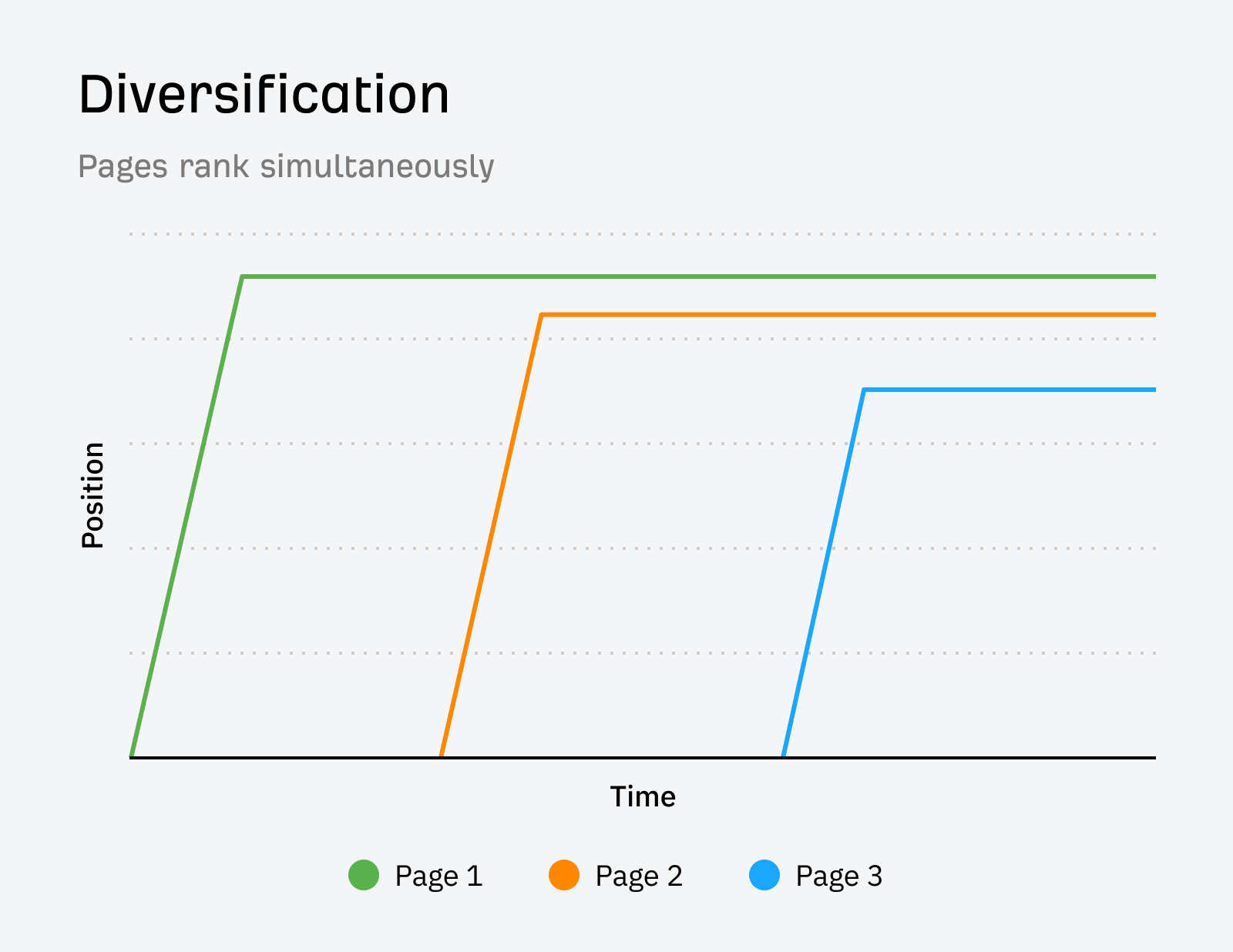

There’s nothing to be fixed here. If Google ranked your site more than once, the system rewarded your content.
Example: “keyword rankings”
For this keyword, we rank with:
- A glossary article ranking in the featured snippet.
- A landing page for a tool at #4 .
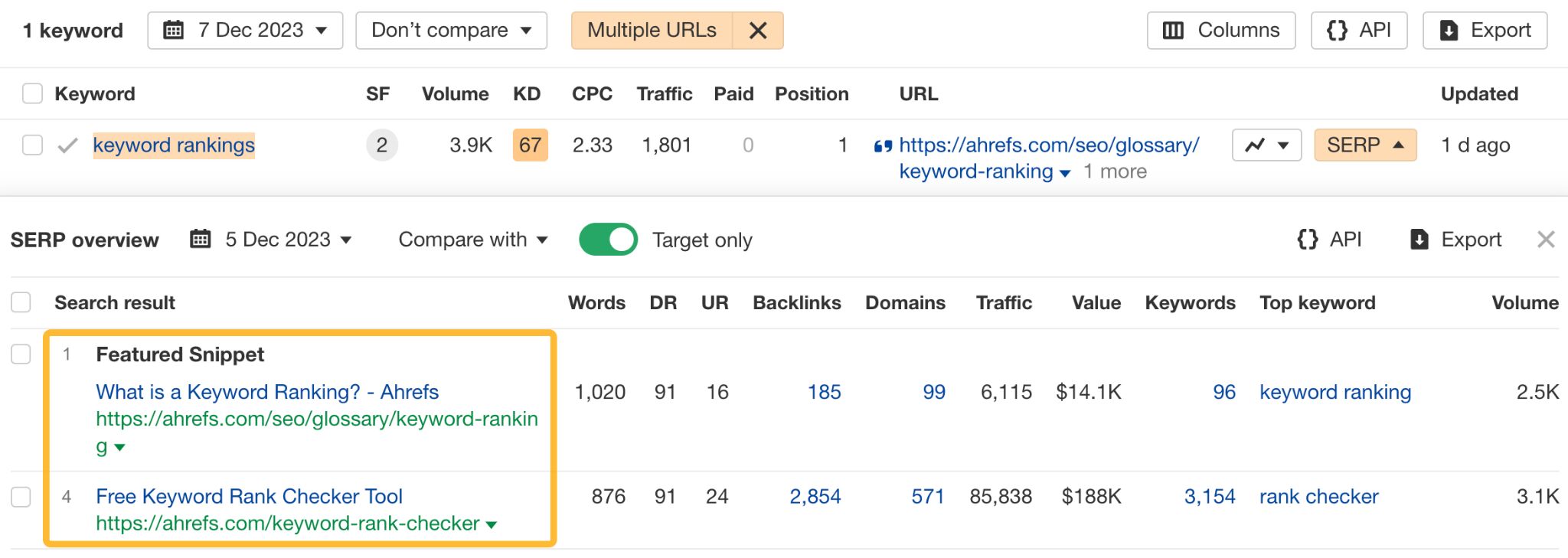

Do the pages swap rankings? No, they’ve been ranking simultaneously for over half a year.


Is there any benefit to consolidating? Unlikely. This way, we serve two kinds of intent: we cater to people who want to get a definition of the term as well as those who want to check their keyword rankings.
Example: “SEO audit”
For this keyword, we rank with:
- A blog article at #4.
- A landing page for a tool at #7.


None of the pages swap rankings.
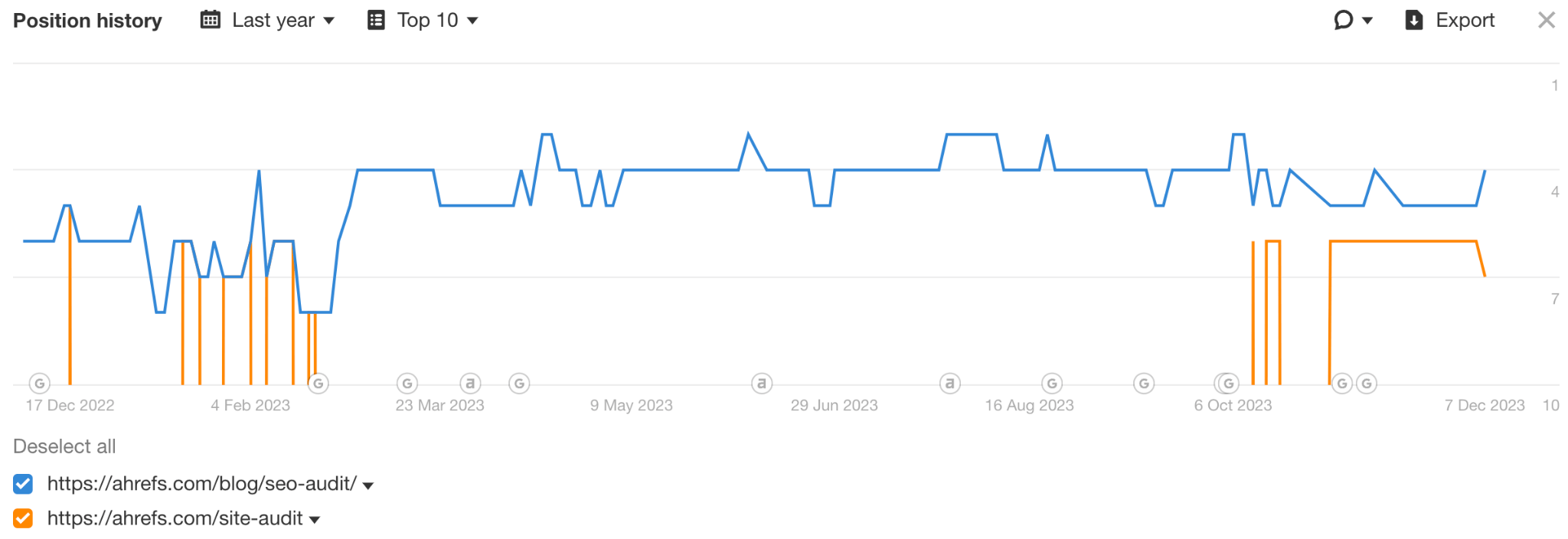

Consolidating them would make no sense because we would need to choose between catering to searchers who want a tool and those who want a guide.
Why rank once when you can rank twice, right?
Sure, if you rank two times in the top 10, you get traffic from both positions (as shown in traffic uplift in the table below). This may seem like an absolute gain in traffic, but it’s a bit tricky. In practice, the new traffic may not be worth it, and you’re also risking pushing down another valuable page.
Let me illustrate this. I took a bunch of keywords where we ranked with 2 URLs in the top ten (otherwise, we’d hardly get any traffic) and looked at the click distribution.
- Traffic uplift — the traffic we gained via ranking another page in top 10 (traffic to new page/traffic to old page).
- Traffic share of the old page — traffic share of the page that ranked first for the keyword.
- Traffic share of the new page — traffic share of the page that came later, i.e., the page that created diversification.
| Keyword | Traffic uplift | Traffic share of the old page | Traffic share of the new page |
|---|---|---|---|
| keyword search | 1.94% | 98.10% | 1.90% |
| seo audit | 37.74% | 72.60% | 27.40% |
| free seo tools | 296.13% | 25.24% | 74.76% |
| affiliate marketing for beginners | 6.63% | 93.78% | 6.22% |
| free keyword research tool | 677.69% | 12.86% | 87.14% |
| keyword rankings | 60.71% | 62.22% | 37.78% |
| how to become an affiliate marketer | 2.39% | 97.67% | 2.33% |
| keyword difficulty | 9233.33% | 1.07% | 98.93% |
As you can see, pages that come later to the SERPs do not always get a bigger traffic share. Just by looking at this small sample, we can see that there are at least three possible scenarios:
- The new page can outrank the old page, either by jumping into a higher position than the original page or pushing the old page lower. More traffic will go to the new page, and in some cases (because that also depends on the CTR), you will gain significantly more traffic.
- The new page will outrank the old, but will get lower CTR, and less traffic. This is what happened in the case of “keyword rankings” — the featured snippet with a definition of a term ranked higher than a landing page with the free tool but got fewer clicks.
- The new page won’t outrank the old page or will rank in site links. Then your diversification efforts will add a few percent of new traffic at best.
Keep in mind that:
- All newly added pages ranked for their unique set of keywords, bringing in additional traffic not listed above.
- We’re only talking about the quantity of traffic here. How qualified that traffic was is a different story.
First off, it’s not something you can fully control. In our case, most of those instances were accidents — Google’s hard-coded propensity to rank some sites multiple times on the same SERP.
But let’s say you see this great opportunity to rank twice in the top 10. It’s definitely possible, but again, a bit tricky. Based on my observations:
- The disparity in clicks between two ranking pages can be significant. Oftentimes, introducing a second page might result in only a marginal increase in traffic while potentially reducing clicks on the originally ranking page.
- It’s more challenging than the good ol’ one-keyword-one-page tactic because the odds are against you since the site diversity update.
- You may need more expensive types of content than what you already have ranking. For instance, a free tool that serves the intent better than an article that already ranks.
- Maintaining top organic rankings for two pages is more difficult than sustaining a single high-ranking spot. In the case of ahrefs.com, situations where a second page maintains a long stable position in the top 10 are rare (see image below).


Most looked like this or worse — ranking and then dropping for months only to reappear for some reason.


Another thing you might try is to double dip in a keyword by ranking videos for keywords with video SERP features or create a hub of definition pages (like our glossary) to rank for featured snippets that require a definition.
But there’s a hack for diversification, too: buy or launch another website.
Google may claim that they are very cautious about ranking the same site twice, but that does not seem to apply to the same business.
To illustrate, when our competitor acquired a popular SEO blog, Google didn’t care about the connection. It has been treating them as two different sites despite being the same business. As a result of diversification, that play allowed them to “double dip” on 8700 keywords ranking in the top 10.
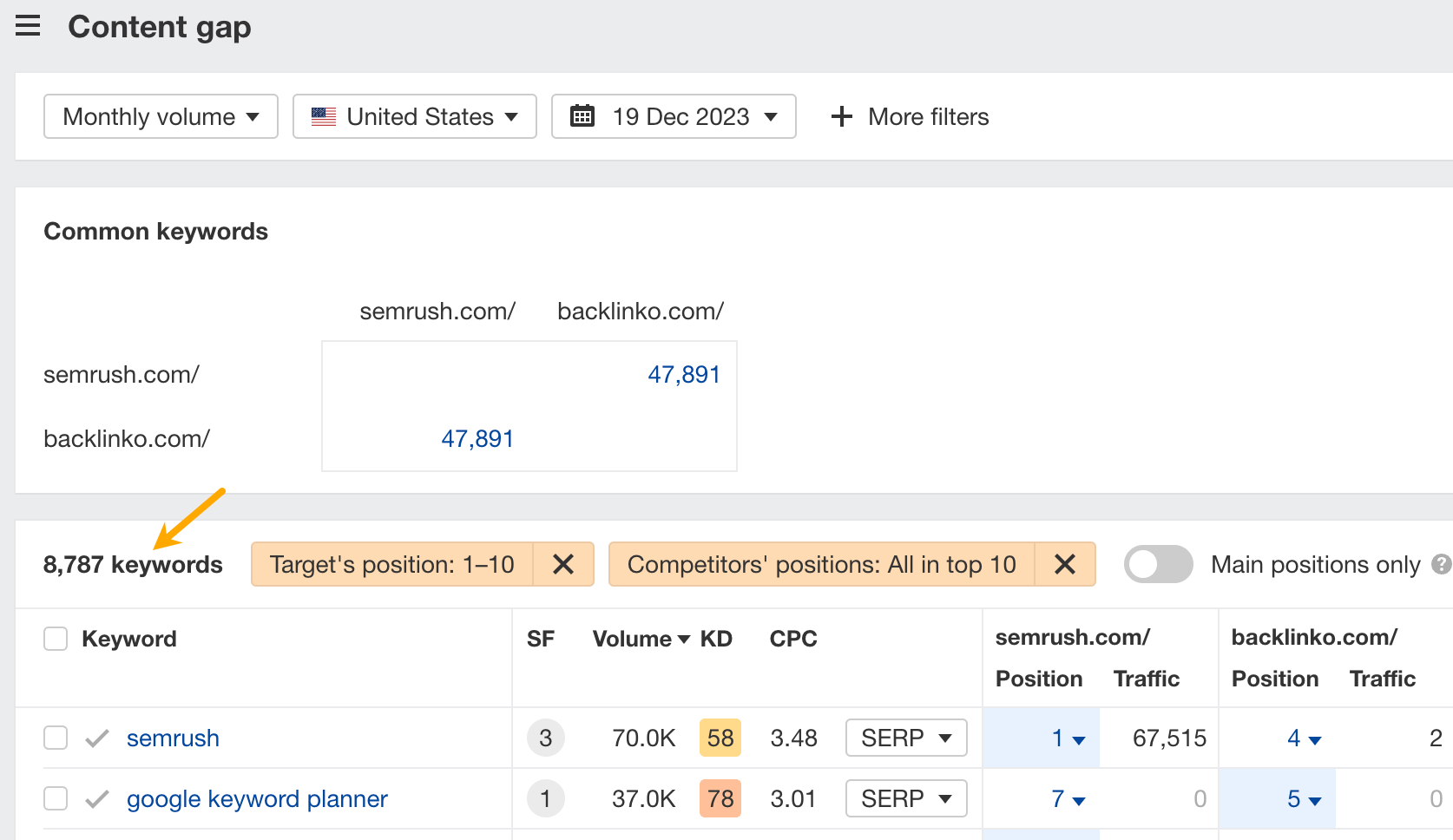

Naturally, they’re not the only example. Glen Allsopp does a fantastic job at following the works of media giants who diversified so well that they literally dominated the SERPs within their niches.
Obviously, more popular keywords will have enough volume to distribute considerable traffic across the top 10. However, that traffic will largely depend on the CTRs, and these are different for each keyword.
If you’re using Ahrefs, open the Traffic share by page report in Keywords Explorer and you’ll get an estimation of how much traffic you can get from each position in the SERPs.
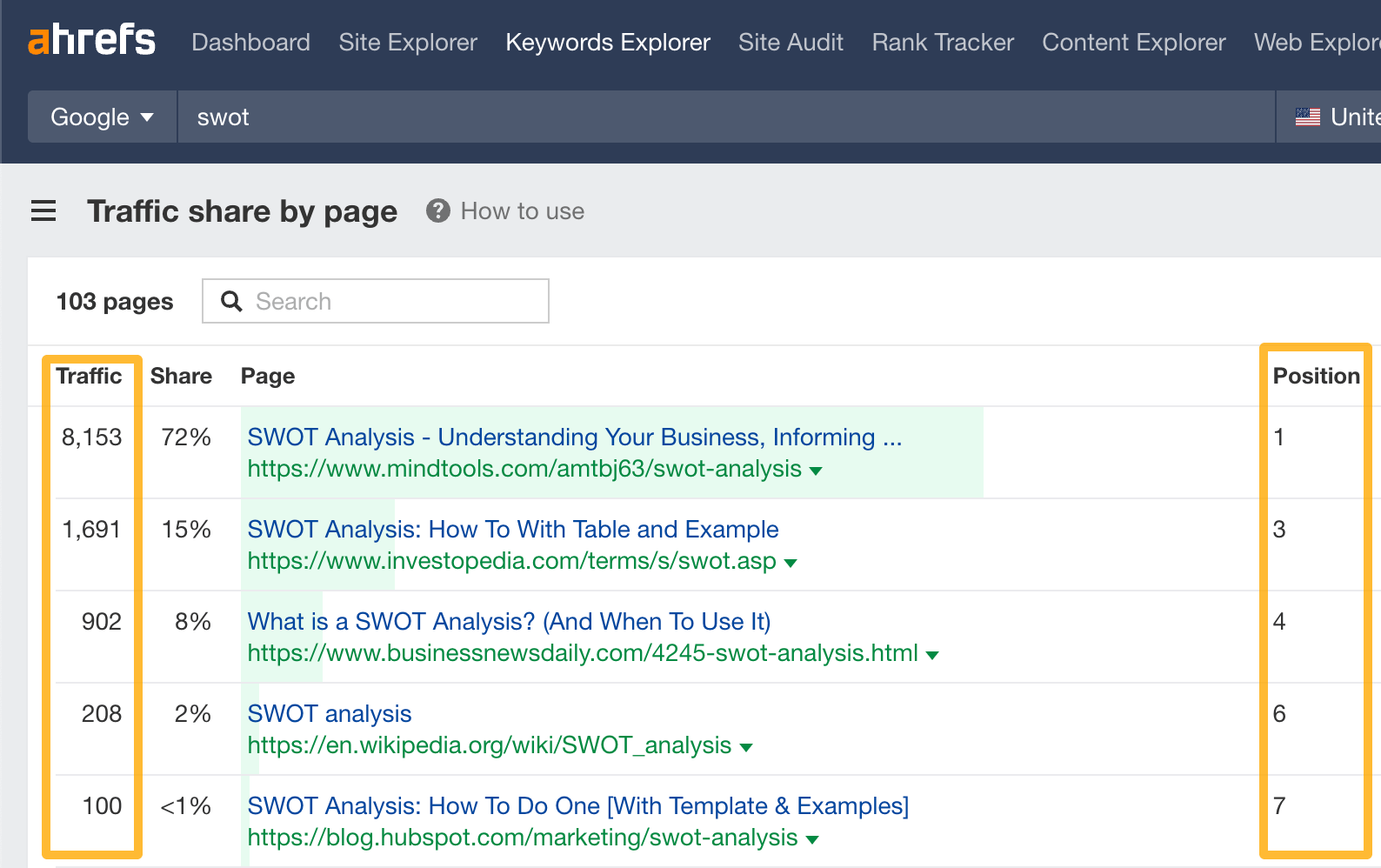

This should give you a good idea of whether taking another position is worth the fight.
Going further, I checked if the metrics and characteristics below had any relation to keyword diversification.
No keyword is too popular for diversification
The median search volume for cannibalized keywords is virtually the same as for our single rankings (50 vs. 40), so we can infer that search volume doesn’t play a determining role.
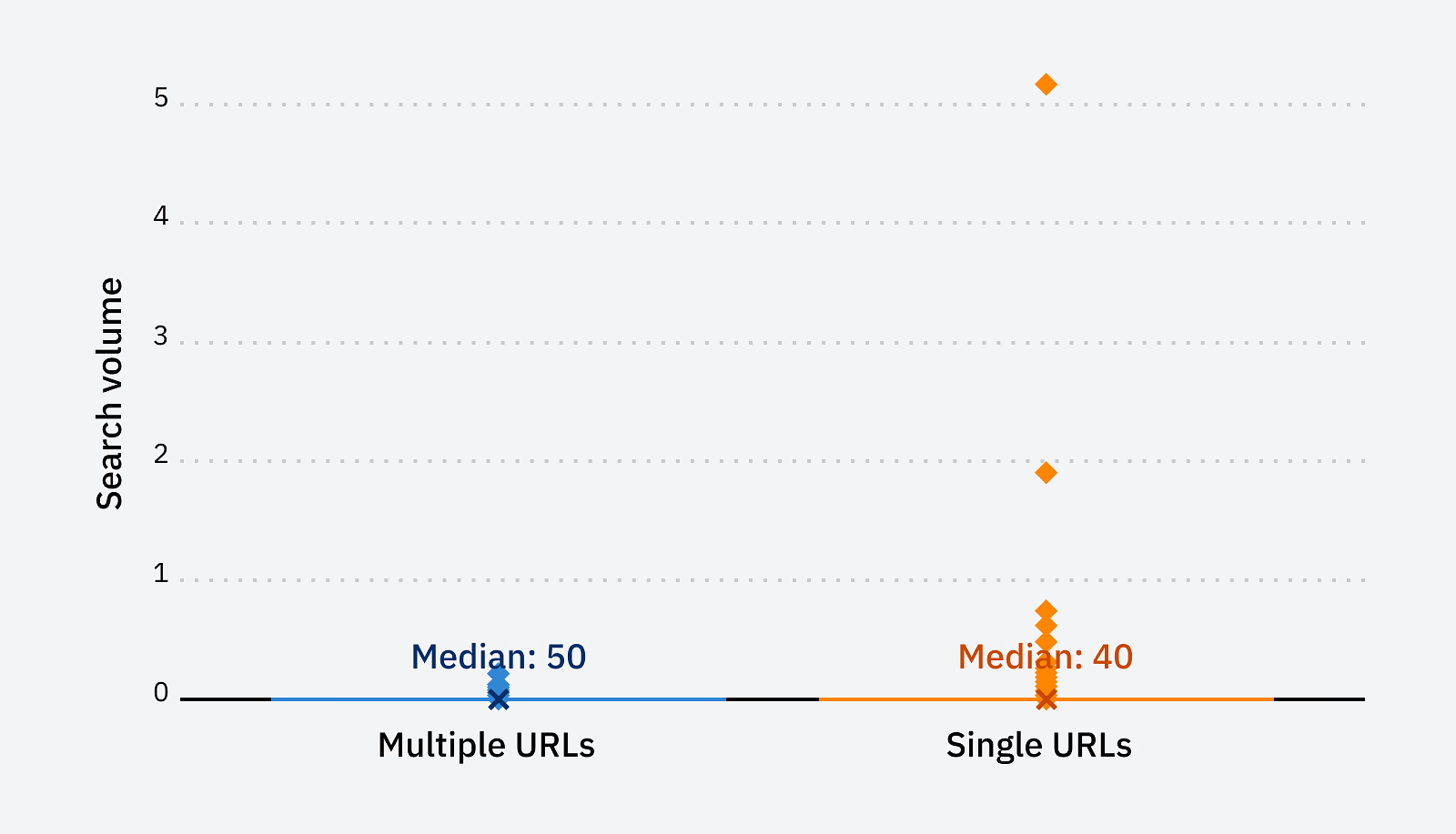

Diversify but make sure to align with search intent
Theoretically, you could rank multiple pages either by aligning with search intents already present on the SERPs or creating something unique but extremely valuable.
If I had to answer this question having only our data, I’d say “follow the crowd”. As you will see in a bit, multiple rankings can happen both with keywords with a single dominant search intent as well as those with a more mixed intent but none of our pages broke outside of already existing types and formats of content.
To illustrate my point, here’s a breakdown of the same top 10 keywords you saw earlier, but this time with a search intent analysis (using our 3C’s framework). In all cases, our ranking content aligns with the existing content types:
| Keyword | Content types in top 10 | Content format (if article) in top 10 | Our ranking content (on Dec 5, 2023) |
|---|---|---|---|
| keyword search | Landing pages (free and premium tools) | – | #8, #10 (both free tools) |
| seo audit | 7 articles, 2 landing pages, | Guides | #5 (guide), #6 (landing page premium tool) |
| free seo tools | 7 articles, 2 landing pages (free tools) | Listicles | #4 (listicle), #7 (free tools landing page) |
| affiliate marketing for beginners | 9 blog posts | Guides | #3 with 3 site links (all guides) |
| free keyword research tool | 8 landing pages, 2 articles | Listicles | #2 (listicle), #4 (free tool) |
| keyword rankings | 7 articles, 2 landing pages (free tools) | 5 guides, 1 definition post, 1 listicle | #1 (article), #4 (free tool) |
| how to become an affiliate marketer | Articles | Guides | #3 with 3 site links (all guides) |
| keyword difficulty | 5 articles, 2 forum posts, 2 landing pages (free and premium tools) | Guides | #1 (free tool), #5 (guide) |
So when there are only article ranking, your best chances might be by diversifying with articles. And if you see different types of pages ranking, say an article and a landing page, there’s a chance of ranking by creating both these types.
Tip
If you’re an Ahrefs user, there’s a nifty AI feature in Keywords Explorer and Site Explorer that estimates the traffic share to each type of intent in the top 10. Check it out.


You don’t need less specific keywords to diversify
We’d expect long-tail keywords to have fewer multiple ranking instances (be it cannibalization or diversification) because the intent would be more defined from the query.
To measure this, I compared word count distribution in keywords with single rankings and multiple rankings using boxplots.


As you can see, the boxplots are almost identical, so no correlation could be at play here.
However, an interesting takeaway here is that if we look at a histogram of word count frequency in the multiple URL data set, we see that most keywords occupied the 3–4 word count range. That indicates ranking multiple times for quite specific search queries is definitely possible.
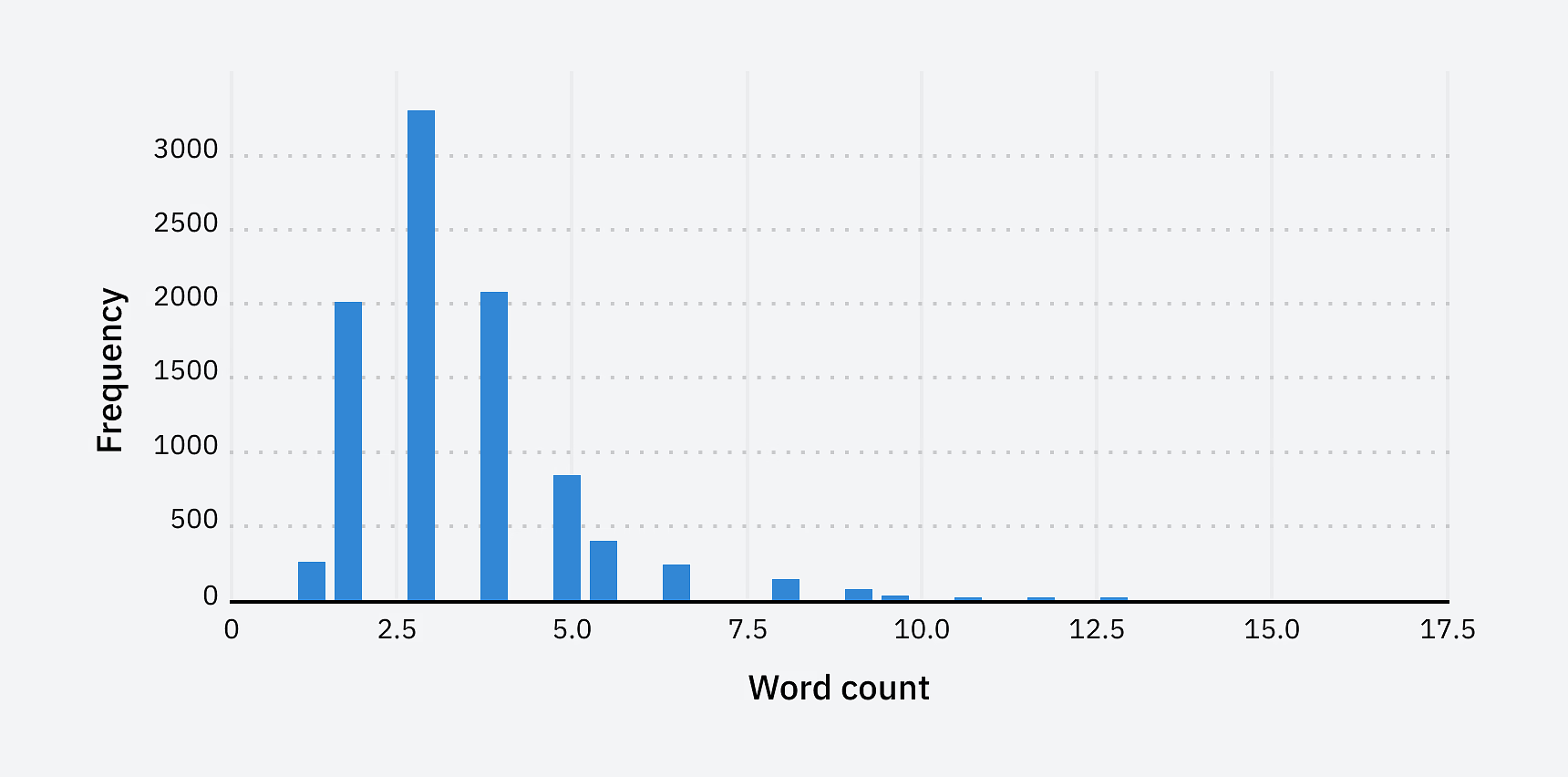

Surprisingly, multiple rankings were more common for high KD keywords
I also wanted to see if it would be harder to get multiple rankings for keywords with high KD value (Ahrefs metric), i.e., keywords with SERPs dominated by pages with a strong backlink profile.
Again, I compared multiple rankings with single rankings.


Here, we can see a clear difference. The median of multiple rankings is way higher than single rankings (64 vs. 37).
One thing is for sure with such a result—you can rank multiple times, even for highly competitive keywords.
Final thoughts
Let’s sum up.
Multiple rankings in Google create two effects: cannibalization and diversification.
This means that classic SEO theory is wrong—you don’t need to go and fix each keyword with multiple rankings.
This also means that you can potentially take advantage of Google’s propensity for multiple rankings and can get more traffic out of a keyword. That said, I’d consider it a pro move, which may have a high opportunity cost compared to targeting some other keyword with just one page. That’s because:
- The additional rankings may not last long.
- You may “outrank yourself”, and the page you outrank will get fewer clicks.
- You may need more expensive types of content than what you already have. For instance, a free tool that serves the intent better than an article that already ranks.
Thanks for reading! If you have any questions or comments, find me on X or LinkedIn.
SEO
Google Rolls Out New ‘Web’ Filter For Search Results

Google is introducing a filter that allows you to view only text-based webpages in search results.
The “Web” filter, rolling out globally over the next two days, addresses demand from searchers who prefer a stripped-down, simplified view of search results.
Danny Sullivan, Google’s Search Liaison, states in an announcement:
“We’ve added this after hearing from some that there are times when they’d prefer to just see links to web pages in their search results, such as if they’re looking for longer-form text documents, using a device with limited internet access, or those who just prefer text-based results shown separately from search features.”
We’ve added this after hearing from some that there are times when they’d prefer to just see links to web pages in their search results, such as if they’re looking for longer-form text documents, using a device with limited internet access, or those who just prefer text-based…
— Google SearchLiaison (@searchliaison) May 14, 2024
The new functionality is a throwback to when search results were more straightforward. Now, they often combine rich media like images, videos, and shopping ads alongside the traditional list of web links.
How It Works
On mobile devices, the “Web” filter will be displayed alongside other filter options like “Images” and “News.”
If Google’s systems don’t automatically surface it based on the search query, desktop users may need to select “More” to access it.
 Screenshot from: twitter.com/GoogleSearchLiaison, May 2024.
Screenshot from: twitter.com/GoogleSearchLiaison, May 2024.More About Google Search Filters
Google’s search filters allow you to narrow results by type. The options displayed are dynamically generated based on your search query and what Google’s systems determine could be most relevant.
The “All Filters” option provides access to filters that are not shown automatically.
Alongside filters, Google also displays “Topics” – suggested related terms that can further refine or expand a user’s original query into new areas of exploration.
For more about Google’s search filters, see its official help page.
Featured Image: egaranugrah/Shutterstock
SEO
Why Google Can’t Tell You About Every Ranking Drop

In a recent Twitter exchange, Google’s Search Liaison, Danny Sullivan, provided insight into how the search engine handles algorithmic spam actions and ranking drops.
The discussion was sparked by a website owner’s complaint about a significant traffic loss and the inability to request a manual review.
Sullivan clarified that a site could be affected by an algorithmic spam action or simply not ranking well due to other factors.
He emphasized that many sites experiencing ranking drops mistakenly attribute it to an algorithmic spam action when that may not be the case.
“I’ve looked at many sites where people have complained about losing rankings and decide they have a algorithmic spam action against them, but they don’t. “
Sullivan’s full statement will help you understand Google’s transparency challenges.
Additionally, he explains why the desire for manual review to override automated rankings may be misguided.
Two different things. A site could have an algorithmic spam action. A site could be not ranking well because other systems that *are not about spam* just don’t see it as helpful.
I’ve looked at many sites where people have complained about losing rankings and decide they have a…
— Google SearchLiaison (@searchliaison) May 13, 2024
Challenges In Transparency & Manual Intervention
Sullivan acknowledged the idea of providing more transparency in Search Console, potentially notifying site owners of algorithmic actions similar to manual actions.
However, he highlighted two key challenges:
- Revealing algorithmic spam indicators could allow bad actors to game the system.
- Algorithmic actions are not site-specific and cannot be manually lifted.
Sullivan expressed sympathy for the frustration of not knowing the cause of a traffic drop and the inability to communicate with someone about it.
However, he cautioned against the desire for a manual intervention to override the automated systems’ rankings.
Sullivan states:
“…you don’t really want to think “Oh, I just wish I had a manual action, that would be so much easier.” You really don’t want your individual site coming the attention of our spam analysts. First, it’s not like manual actions are somehow instantly processed. Second, it’s just something we know about a site going forward, especially if it says it has change but hasn’t really.”
Determining Content Helpfulness & Reliability
Moving beyond spam, Sullivan discussed various systems that assess the helpfulness, usefulness, and reliability of individual content and sites.
He acknowledged that these systems are imperfect and some high-quality sites may not be recognized as well as they should be.
“Some of them ranking really well. But they’ve moved down a bit in small positions enough that the traffic drop is notable. They assume they have fundamental issues but don’t, really — which is why we added a whole section about this to our debugging traffic drops page.”
Sullivan revealed ongoing discussions about providing more indicators in Search Console to help creators understand their content’s performance.
“Another thing I’ve been discussing, and I’m not alone in this, is could we do more in Search Console to show some of these indicators. This is all challenging similar to all the stuff I said about spam, about how not wanting to let the systems get gamed, and also how there’s then no button we would push that’s like “actually more useful than our automated systems think — rank it better!” But maybe there’s a way we can find to share more, in a way that helps everyone and coupled with better guidance, would help creators.”
Advocacy For Small Publishers & Positive Progress
In response to a suggestion from Brandon Saltalamacchia, founder of RetroDodo, about manually reviewing “good” sites and providing guidance, Sullivan shared his thoughts on potential solutions.
He mentioned exploring ideas such as self-declaration through structured data for small publishers and learning from that information to make positive changes.
“I have some thoughts I’ve been exploring and proposing on what we might do with small publishers and self-declaring with structured data and how we might learn from that and use that in various ways. Which is getting way ahead of myself and the usual no promises but yes, I think and hope for ways to move ahead more positively.”
Sullivan said he can’t make promises or implement changes overnight, but he expressed hope for finding ways to move forward positively.
Featured Image: Tero Vesalainen/Shutterstock
SEO
56 Google Search Statistics to Bookmark for 2024

If you’re curious about the state of Google search in 2024, look no further.
Each year we pick, vet, and categorize a list of up-to-date statistics to give you insights from trusted sources on Google search trends.
- Google has a web index of “about 400 billion documents”. (The Capitol Forum)
- Google’s search index is over 100 million gigabytes in size. (Google)
- There are an estimated 3.5 billion searches on Google each day. (Internet Live Stats)
- 61.5% of desktop searches and 34.4% of mobile searches result in no clicks. (SparkToro)
- 15% of all Google searches have never been searched before. (Google)
- 94.74% of keywords get 10 monthly searches or fewer. (Ahrefs)
- The most searched keyword in the US and globally is “YouTube,” and youtube.com gets the most traffic from Google. (Ahrefs)
- 96.55% of all pages get zero search traffic from Google. (Ahrefs)
- 50-65% of all number-one spots are dominated by featured snippets. (Authority Hacker)
- Reddit is the most popular domain for product review queries. (Detailed)
- Google is the most used search engine in the world, with a mobile market share of 95.32% and a desktop market share of 81.95%. (Statista)


- Google.com generated 84.2 billion visits a month in 2023. (Statista)
- Google generated $307.4 billion in revenue in 2023. (Alphabet Investor Relations)
- 63.41% of all US web traffic referrals come from Google. (SparkToro)
- 92.96% of global traffic comes from Google Search, Google Images, and Google Maps. (SparkToro)
- Only 49% of Gen Z women use Google as their search engine. The rest use TikTok. (Search Engine Land)
- 58.67% of all website traffic worldwide comes from mobile phones. (Statista)
- 57% of local search queries are submitted using a mobile device or tablet. (ReviewTrackers)


- 51% of smartphone users have discovered a new company or product when conducting a search on their smartphones. (Think With Google)
- 54% of smartphone users search for business hours, and 53% search for directions to local stores. (Think With Google)
- 18% of local searches on smartphones lead to a purchase within a day vs. 7% of non-local searches. (Think With Google)
- 56% of in-store shoppers used their smartphones to shop or research items while they were in-store. (Think With Google)
- 60% of smartphone users have contacted a business directly using the search results (e.g., “click to call” option). (Think With Google)
- 63.6% of consumers say they are likely to check reviews on Google before visiting a business location. (ReviewTrackers)
- 88% of consumers would use a business that replies to all of its reviews. (BrightLocal)
- Customers are 2.7 times more likely to consider a business reputable if they find a complete Business Profile on Google Search and Maps. (Google)
- Customers are 70% more likely to visit and 50% more likely to consider purchasing from businesses with a complete Business Profile. (Google)
- 76% of people who search on their smartphones for something nearby visit a business within a day. (Think With Google)
- 28% of searches for something nearby result in a purchase. (Think With Google)
- Mobile searches for “store open near me” (such as, “grocery store open near me” have grown by over 250% in the last two years. (Think With Google)
- People use Google Lens for 12 billion visual searches a month. (Google)
- 50% of online shoppers say images helped them decide what to buy. (Think With Google)
- There are an estimated 136 billion indexed images on Google Image Search. (Photutorial)
- 15.8% of Google SERPs show images. (Moz)
- People click on 3D images almost 50% more than static ones. (Google)
- More than 800 million people use Google Discover monthly to stay updated on their interests. (Google)
- 46% of Google Discover URLs are news sites, 44% e-commerce, 7% entertainment, and 2% travel. (Search Engine Journal)
- Even though news sites accounted for under 50% of Google Discover URLs, they received 99% of Discover clicks. (Search Engine Journal)


- Most Google Discover URLs only receive traffic for three to four days, with most of that traffic occurring one to two days after publishing. (Search Engine Journal)
- The clickthrough rate (CTR) for Google Discover is 11%. (Search Engine Journal)
- 91.45% of search volumes in Google Ads Keyword Planner are overestimates. (Ahrefs)
- For every $1 a business spends on Google Ads, they receive $8 in profit through Google Search and Ads. (Google)
- Google removed 5.5 billion ads, suspended 12.7 million advertiser accounts, restricted over 6.9 billion ads, and restricted ads from showing up on 2.1 billion publisher pages in 2023. (Google)
- The average shopping click-through rate (CTR) across all industries is 0.86% for Google Ads. (Wordstream)
- The average shopping cost per click (CPC) across all industries is $0.66 for Google Ads. (Wordstream)
- The average shopping conversion rate (CVR) across all industries is 1.91% for Google Ads. (Wordstream)
- 58% of consumers ages 25-34 use voice search daily. (UpCity)
- 16% of people use voice search for local “near me” searches. (UpCity)
- 67% of consumers say they’re very likely to use voice search when seeking information. (UpCity)
- Active users of the Google Assistant grew 4X over the past year, as of 2019. (Think With Google)
- Google Assistant hit 1 billion app installs. (Android Police)
- AI-generated answers from SGE were available for 91% of entertainment queries but only 17% of healthcare queries. (Statista)
- The AI-generated answers in Google’s Search Generative Experience (SGE) do not match any links from the top 10 Google organic search results 93.8% of the time. (Search Engine Journal)
- Google displays a Search Generative element for 86.8% of all search queries. (Authoritas)


- 62% of generative links came from sources outside the top 10 ranking organic domains. Only 20.1% of generative URLs directly match an organic URL ranking on page one. (Authoritas)
- 70% of SEOs said that they were worried about the impact of SGE on organic search (Aira)
Learn more
Check out more resources on how Google works:
-

 PPC7 days ago
PPC7 days agoHow the TikTok Algorithm Works in 2024 (+9 Ways to Go Viral)
-

 SEO6 days ago
SEO6 days agoHow to Use Keywords for SEO: The Complete Beginner’s Guide
-

 MARKETING7 days ago
MARKETING7 days agoHow To Protect Your People and Brand
-

 MARKETING4 days ago
MARKETING4 days agoAdvertising on Hulu: Ad Formats, Examples & Tips
-

 MARKETING5 days ago
MARKETING5 days agoUpdates to data build service for better developer experiences
-

 MARKETING1 day ago
MARKETING1 day ago18 Events and Conferences for Black Entrepreneurs in 2024
-

 MARKETING6 days ago
MARKETING6 days agoThe Ultimate Guide to Email Marketing
-

 WORDPRESS4 days ago
WORDPRESS4 days agoBest WordPress Plugins of All Time: Updated List for 2024




